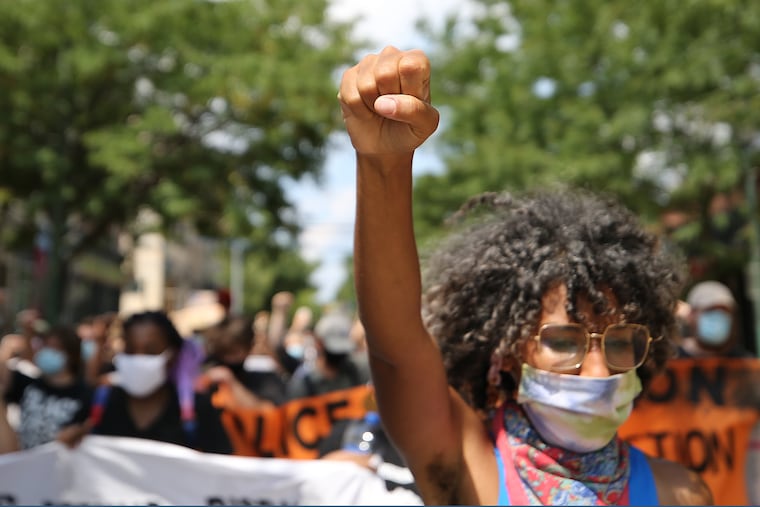Community groups rally in West Philly to protest Penn, Drexel cops’ presence at 52nd Street teargassing
“For too long, students, and particularly Black students, have been placated, silenced, and traumatized when expressing their concerns of policing on campus,” a rally organizer told the crowd.

Through face masks, roughly 150 people chanted calls to defund the police and to bring justice for West Philadelphia residents whom city police teargassed in May. They marched from Drexel University’s bronze dragon statue at 33rd and Market Streets to the front door of the University of Pennsylvania’s police building to protest the presence of the campuses’ officers as Philadelphia police attacked residents along the 52nd Street corridor.
Tianna Williams, president of Drexel’s Black Action Committee, said policing is “infected” by biases and systemic racism and does not protect Black communities, including students.
“For too long, students, and particularly Black students, have been placated, silenced, and traumatized when expressing their concerns of policing on campus,” she said to the crowd. “Our concerns about profiling, officer conduct, and administrative responses are met with shallow apologies and temporary fixes. For too long, the West Philadelphia community that we live with have not only had to deal with the exploitation and gentrification of Drexel University and UPenn, but terrorization from the Philadelphia Police Department, the Drexel University Police Department, and Penn’s police department.”
Groups consisting of students, faculty, and alumni at the universities, as well as Black Lives Matter Philadelphia, Reclaim Philadelphia, Drexel’s community legal clinic, Philadelphia Jobs with Justice, and other community groups organized Sunday’s rally.
On May 31, as city residents protested the Minneapolis police killing of George Floyd, Philadelphia police launched tear gas canisters that choked residents in their homes. Campus police officers from Drexel and Penn showed up to assist city officers that day, although the universities have said their private, tuition-funded departments didn’t use tear gas, rubber bullets, or pepper spray as the city department did.
Newly formed groups including Police Free Penn and Drexel Community for Justice are renewing calls for the defunding of the campus police departments as part of a national call for the redirecting of funds away from policing and toward education and social services. Community activists say the events along 52nd Street have accelerated longstanding calls for change in how the departments operate and treat residents in the areas surrounding the campuses.
“Safety doesn’t mean more police,” Samantha Rise, a community activist and program director of the nonprofit Girls Rock Philly, said to the crowd. “It means more [community] resources.”
» READ MORE: Penn, Drexel officers’ presence on 52nd Street renews calls to defund campus police
During the demonstration at Drexel, a few drivers read the banners and honked in support. But one pulled over and got out to confront the protesters. “You don’t want someone to protect you?” she asked. In reply, Rise said the people can protect themselves and denounced the militarization of police departments. Protesters shouted down the driver, who after a couple of minutes, got back in her van and drove away.
As protesters marched from Drexel to Penn’s police building, they chanted, “Who protects us? We protect us! Who protects students? We protect students! Who protects teachers? We protect teachers!”
In response to the protesters’ demands, Niki Gianakaris, Drexel’s executive director of media relations, pointed to the steps the school is taking, including creating an anti-racism task force and a Drexel Center for Black Culture, and starting an independent review of the Drexel police by former Philadelphia Police Commissioner Charles Ramsey. (Organizers of Sunday’s rally said they didn’t want Ramsey involved, in part because of his ties to the Philadelphia Police Department, which they also want to defund.)
“The university has heard the concerns being raised within the Drexel community and is continuing to develop ways to foster productive dialogue and work collaboratively to find solutions,” the university said in a statement Sunday.
The groups that assembled are demanding the universities immediately reduce funding to their police departments by 50% and dissolve the forces by 2025; make payments in lieu of taxes to the Philadelphia School District and the city as restitution; publicly release public safety budget data; and disclose financial and partnership agreements with city police. Penn withdrew funding to the Philadelphia Police Foundation in June.
» READ MORE: 'I couldn't breathe': Inside the West Philly neighborhood the police teargassed
The groups also want Penn to fire Maureen Rush, head of the school’s police force, vice president for public safety for the last two decades, and a former Philadelphia police officer.
In a statement, the university said it was “extremely fortunate” to have Rush.
“The Penn Police Department is regularly ranked as the best university police department in the country,” Penn said in the statement. “This is due in great measure to the extraordinary leadership of Maureen Rush, who is highly regarded and respected by all who know and work with her.”
» READ MORE: Philly police actions on 52nd Street under investigation, but distrust of cops keeps some witnesses silent
Sergio Cea, an organizer at Reclaim Philadelphia and a Democratic committee person in the 46th Ward, said the Penn police department always says safety and security “is a shared responsibility.”
“I didn’t feel safe or secure on May 31,” he said. “And, to be honest, I don’t ever feel safe and secure with police in my community, period.”
He said he saw the spirit of shared responsibility play out on May 31 through neighbors who protected Black-owned businesses with their bodies, and neighbors and community activists who went to the scene with medical supplies and water.
“Only in West Philadelphia did you see police in militarized tactical gear shooting tear gas canisters down residential neighborhoods, suffocating our community members who were doing what the government told them to do — stay home, stay safe,” Cea said. “Ask the families that had tear gas seeping into their homes, burning their kids’ eyes: Did they feel safe?”